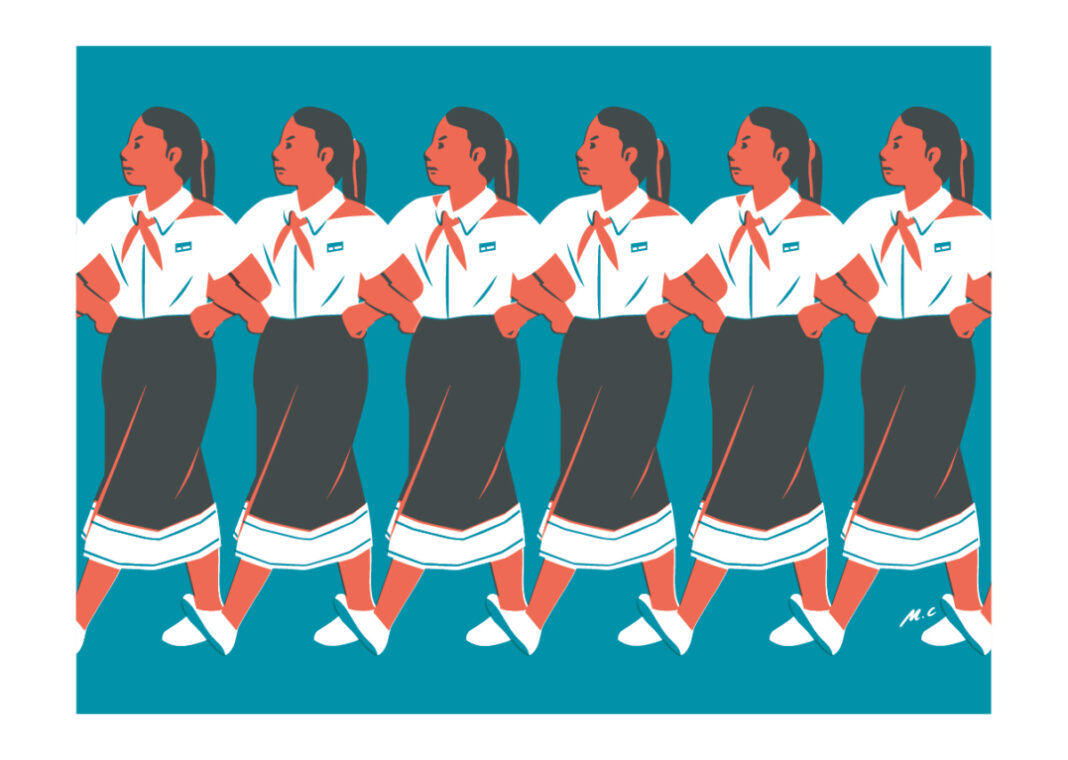The Laotian Times interviews visual artist “The Vientianist,” whose work combines digital processes and vintage styles into celebratory, tongue-in-cheek scenes of Lao life.
Visual artists in Laos inevitably face material constraints in their art processes. “You can’t get a lot of materials here,” the artist who goes by “The Vientianist” tells me. “The only place I’ve been able to do lino prints, for example, is in school,” she says, referring to her time as a student at Vientiane International School’s old high school. “If you want specific art materials you usually have to order them from Thailand, and that gets expensive fast.”
Electronics, on the other hand, are now more accessible and widely used in Laos, so transitioning from a kid who loved to draw to an adult working on a tablet, using Procreate, made sense for her. She is part of the more general digital art boom in Laos, evidenced by the explosion of graphic design studios in Vientiane.
“People see the value in graphic design here now,” she says. ”They understand that it’s a necessary part of social media and advertising.” And for artists like her who, of course, need to support themselves, working in graphic design can be a day job which makes chasing the real passion of art-for-art’s-sake possible. The Vientianist’s favorite graphic design house, Ork Baeb Lao, has developed an illustration style that she says “blends Lao identity with funky, young styles.”

Creating her art digitally has given The Vientianist the opportunity to recreate the look and texture of those older processes, like lino printing, without the need for costly imported materials. This led her to think, “what if I could imagine Lao art from when those art processes were booming in other places, what if people in Laos did have access to those materials in the past? What would Lao art from the 1960s look like, for example, if people could have made linoprints?”

In one piece, inspired by a Soviet anti-drinking ad, a man pushes away a glass of beer. ບໍ່ (No!) the poster reads. “I thought it would be funny. On the one hand, it’s not something anyone really does in Lao culture. You know, you’re at a wedding, and people are encouraging you to drink more beer. Who in Laos says no? But also, the piece reminds people that you can say no to beer.”
It’s through this kind of generous, good-natured teasing that The Vientianist has forged a uniquely Lao social commentary. And with art that imagines the processes of yore, the images are visually distinct. “I like the way that printers used color when they could only use a few colors. The men had such pink lips!”
The Vientianist works in series which draw from pop art, travel posters, and elsewhere, depicting Laos in ways that are radically different, and often much funnier, than the traditional Lao art which she says lacks perspective, depicting exclusively idyllic symbols of Laos–champa flowers, elephants, and sunsets–in a singular and reverent way.

This isn’t to say that The Vientianist is never reverent. But even in her most respectful pieces she finds ways to imbue the compositions with a refreshing blend of both past and present elements. In one piece commemorating Kao Pansa (the beginning of Buddhist lent), she depicts traditional offerings in bright colors, placing traditional sticky rice alongside a trio of packaged, processed custard cakes, celebrating the traditional alms while also giving a more contemporary and accurate view of what these offerings contain today.
In “Tum Shop Lady” the artist heroically depicts the often-unsung heroes behind a part of Lao culture which arguably brings some of the most joy in people’s daily lives: papaya salad. The tum lady is powerful, strong, and serious. She’s a hard worker, but not in a tragic way. The colors are candy-vivid and happy, like the strong flavors she pounds together with her kok and sark.

Of course, The Vientianist doesn’t work in a vacuum. But while she has traveled internationally, to France and to the United States, it’s not the old masters in the west that inspire her. Rather, it’s the other digital artists she finds on Instagram, both from around the world and within Laos, from who she learns most about art.
“There are so many amazing new Lao artists I could mention here. Young Lao people are doing really cool things digitally. They’re working with things like calligraphy in surprising new ways. One artist I admire, La Vientianaise, works in photography, sometimes combining it with illustration and design. She even imagined public art in Laos, showing what it’d be like if we had big public murals here in Vientiane.”
The Vientianist hopes to share a large gallery show with some of these other imaginative Lao artists, to see their art make it from the screen to the gallery wall.
When asked what advice she has for other young Lao artists, she only laughs. “You’re not gonna get a motivational quote from me,” she says. But uptight motivational preachiness isn’t what we need from The Vientianist. It’s that humor, curiosity, and humility which make her perspective so noteworthy.



